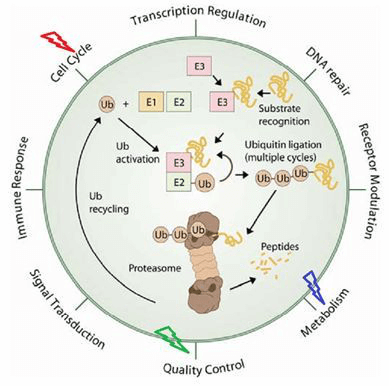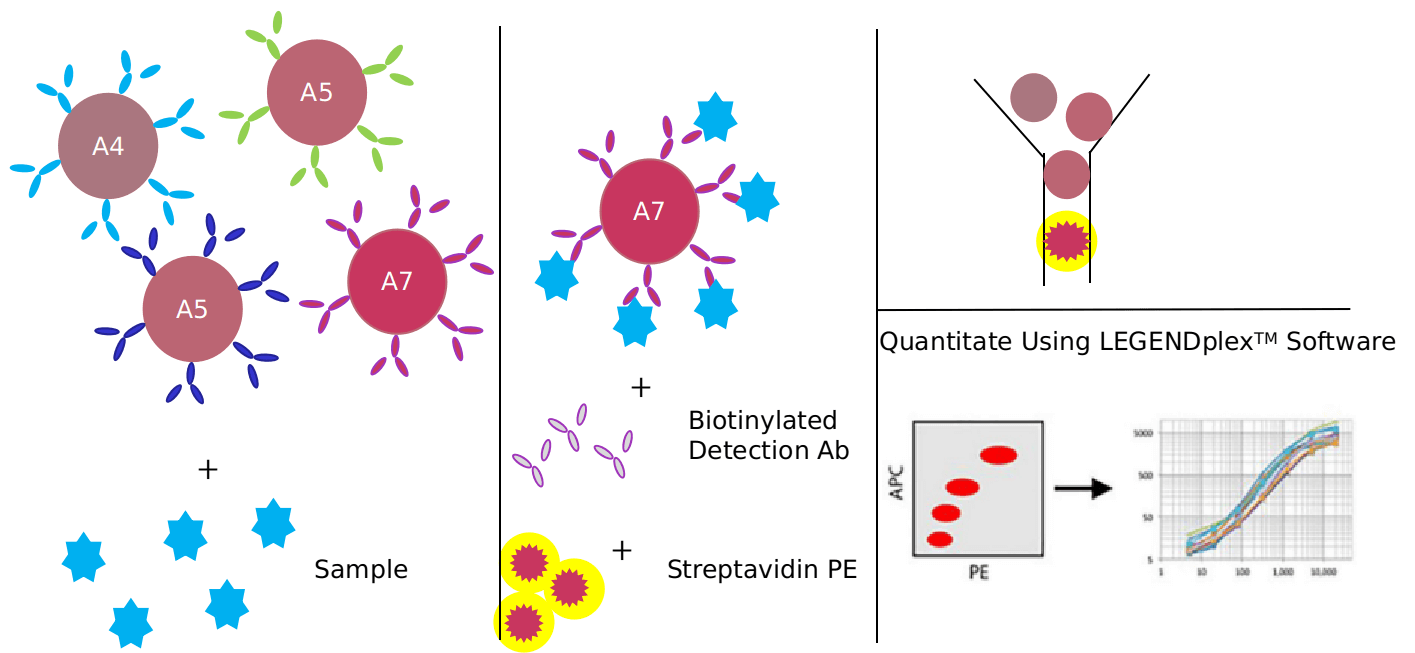Introduction to ubiquitin proteasome signaling pathway
Based on Luminex technology platform, Creative Proteomics provides analysis services for key targets of ubiquitin proteasome signaling pathway.
 Protein degradation mediated by the ubiquitin proteasome pathway is an important mechanism for the body to regulate the level and function of intracellular proteins. The components responsible for performing this regulatory process include ubiquitin and its initiating enzyme system and proteasome system. The ubiquitin priming enzyme system is responsible for activating ubiquitin and binding it to the protein to be degraded to form a polyubiquitin chain of the target protein, that is, ubiquitination. The proteasome system can recognize and degrade ubiquitinated proteins. In addition, there is another type of deubiquitinated protease that dissociates the ubiquitin chain molecule in the cell to form a reverse regulation.
Protein degradation mediated by the ubiquitin proteasome pathway is an important mechanism for the body to regulate the level and function of intracellular proteins. The components responsible for performing this regulatory process include ubiquitin and its initiating enzyme system and proteasome system. The ubiquitin priming enzyme system is responsible for activating ubiquitin and binding it to the protein to be degraded to form a polyubiquitin chain of the target protein, that is, ubiquitination. The proteasome system can recognize and degrade ubiquitinated proteins. In addition, there is another type of deubiquitinated protease that dissociates the ubiquitin chain molecule in the cell to form a reverse regulation.
The ubiquitin-proteasome pathway (upp) is composed of ubiquitinub and a series of related enzymes. In addition to ubiquitin, it also includes 4 enzyme families: ubiquitin-activating enzyme (E1), ubiquitin coupling enzyme (ubiquitin-conjugatingenzymesE2s) is also called ubiquitin carrier protein (ubiquitin-carrierprotein), ubiquitin-protein ligase (ubiquitin-ligatingenzymes (E3s) and proteasome (proteasome). Both protein ubiquitination and deubiquitination need to be mediated by multiple enzymes. Upp has both a high degree of substrate diversity and diversity for different regulatory mechanisms.
Ubiquitin-proteasome-mediated protein degradation pathways mainly include:
- The activation of ubiquitin: the carboxyl group of the glycine end of ubiquitin is connected to the sulfhydryl group of ubiquitin activating enzyme E1. This step requires ATP as energy to finally form a thioester bond between ubiquitin and ubiquitin activating enzyme E1.
- E1 delivers the activated ubiquitin to the ubiquitin-conjugating enzyme E2 through the esterification process.
- Ubiquitin ligase E3 connects E2-bound ubiquitin to the target protein and releases E2 to form a specific ubiquitinated protein.
- The ubiquitinated protein is recognized and bound by a specific proteasome, and finally the protein is broken down into short peptides or amino acids under the catalysis of proteases.
Our detectable targets:
| E1 | BID | IAPs | TLR3 | SODD | Bad |
| E2 | Bax | PIDD | MYD88 | Rac1 | TLR4 |
| E3 | RIP1 | TRAF-2 | FADD | APAF-1 | BID |
| FADD | IRF7 | Mda-5 | NFκB | RIG-1 | TRAF3 |
| GAS | IRF9 | MEKK1 | p38 | RIP1 | TRAF5 |
| IKK-α | IRS1 | MEK6 | p50 | SLP76 | TRAM |
| IKK-β | IRS2 | MSK1 | p65 | Tak1 | TRIF |
| IPS-1 | ISGF3 | MSK2 | PI3K | TBK1 | Vav |
| IRAK1 | ISRE | mTOR | PKR | TLR3 |
Technology platform:
We provide Luminex technology for ubiquitin proteasome signaling pathway analysis.
Luminex technology is a multifunctional liquid phase analysis platform developed on the basis of colored microspheres, laser technology, applied fluidics and high-speed digital signal processing technology. The core is to encode polypropylene microspheres or magnetic microspheres with fluorescent dyes. By adjusting the different ratios of the two fluorescent dyes, up to 100 microspheres with different fluorescence spectra can be obtained. Antigen-antibody, enzyme-substrate, ligand-receptor binding reactions and nucleic acid hybridization reactions are performed on microspheres with different fluorescence encoding. Qualitative and quantitative analysis by laser detection of microsphere coding and reporter fluorescence separately.
Protein degradation mediated by the ubiquitin proteasome pathway is an important mechanism for the body to regulate the level and function of intracellular proteins. The proteasome pathway plays an important role in plant growth regulation, animal reproduction and development, tumorigenesis and neurological diseases.
In addition to Luminex Multiplex Assay, Enzyme-linked immunosorbent assay (ELISA), Flow cytometry (FACS analysis) technology can also be provided to meet other customer needs.
Advantages of Luminex technology:
- High-throughput and high-speed: Each microsphere is used as a separate test body, which can perform a large number of biological tests at the same time. It only needs 10~201 samples to test up to 100 indicators at a time, and the fastest can reach 10,000 tests /hour.
- Good repeatability: The Luminex detection platform directly reads the fluorescence value, which is more stable and sensitive: 100 microspheres of each type are detected, and the median value is taken as the result, which is equivalent to 100 repeated detections for each sample.
- Low cost: Simultaneous detection of multiple indicators of a sample can save time, samples, reduce detection costs, and improve analysis efficiency.

Application of our service:
- To study the regulation mechanism of ubiquitin proteasome signal pathway in disease
- To study the effect of each virus on ubiquitin proteasome signaling pathway
- To study the effects of drugs or therapies on ubiquitin proteasome signaling pathways
Creative Proteomics has developed a signal pathway target detection platform. We are not limited to providing ubiquitin proteasome signal path detection services, but can also provide other signal path detection services. If you want to detect other targets, please contact us and we will customize the service for you. Look forward to working with you.
References:
- Luciana C. Furtado, Anelize Bauermeister, et al. Isolated From the Brazilian Endemic Tunicate Euherdmania sp. Produces Dihydroeponemycin and Analogs With Potent Antiglioma Activity, Frontiers in Marine Science, 2021.
- Chee Wai Fhu, Azhar Ali, Dysregulation of the Ubiquitin Proteasome System in Human Malignancies: A Window for Therapeutic Intervention, Cancers, 2021.

